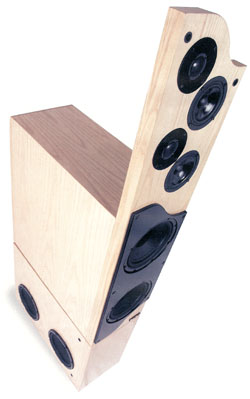
Reviewer Profiles
Roy Gregory
 Regular readers will know that I moved house this year, a trauma
documented at some length in Issues 40 and 41. I'll not bore you with
repetition, other than to note that the room gets better and better
with experience.
Regular readers will know that I moved house this year, a trauma
documented at some length in Issues 40 and 41. I'll not bore you with
repetition, other than to note that the room gets better and better
with experience.
The system has also changed, although in most cases its been evolution rather than revolution. Thus the Kuzma Stabi Reference and Triplanar combination became an XL/Airline set up: the Linear A power amp was supplemented with Linear B mono-blocs. However, there's one (very large) exception to that rule, in the angular shape of the Nola Pegasus. They're a long story and one that starts near the beginning of the year.
Back in February Harry Pearson of TAS invited (commanded) me to visit him at his Sea Cliff home to experience a new level of performance he'd achieved from his legendary reference system. When you break new ground, defining what's happening and refining that experience is the most challenging task facing the audio reviewer. Believe me when I say that all help is gratefully received. As soon as I heard HP's system I understood both his excitement and the problem he faced in communicating the revelatory nature of the experience. Undermined by years of intemperate exaggeration, the language of audio criticism was severely challenged by the task of describing and communicating the importance of the performance breakthrough he'd achieved. Well, Harry Pearson isn't HP (his audio alter ego) for nothing and he has proved equal to that task, the results readable in Issue 156 of the abso!ute sound, his review of the ASR Emitter II amplifier. It's a model piece and well worth seeking out, but it doesn't cover the conundrum facing yours truly.
The problem is that HP has access to an unbelievable range and variety of equipment. Well, so do I. But what I don't/can't have is the massive, four-tower Nola Grand Reference speaker system that he uses, an astonishing macro lens onto the performance of the driving system. The performance breakthrough was there, but it was the speakers that let you hear it. The problem of course is, that once heard it's awfully hard to do without the benefits. How could I translate this new level of musical insight into my home environment?
|
System: Analogue Front-ends Kuzma Stabi XL with Airline tonearm VPI TNT6 with JMW 12 tonearm, all wands wired with Nordost Valhalla internal cabling Clearaudlo Master Reference and Master TQI tonearm VPI Scout and JMW 9 tonearm Koetsu Jade Platinum Lyra Titan Lyra Helikon Mono (Everybody should have at least one mono cartridge and a tonearm to take it!) ClearAudio Insider Reference Cartridge Man Music Maker TEAD Groove Plus phono-stage
Digital Front-end
Amplification
Loudspeakers
Nola Pegasus loudspeakers
Ancillaries |
I've been living with the Pegasus for around six months now and the results are exceptional. Not only has Carl Marchisotto successfully embodied the performance attributes of the Grand Reference into a scaled down realisation, in tonal and harmonic terms he may well even have exceeded them. The all AlNiCo driver line-up is astonishingly even and full of natural instrumental colour. The independence and separation of individual instruments within the coherent whole that makes the Sea Cliff system so dramatic and impressive is further enhanced by the trueness of shading, dynamic and harmonic, that defines the character of each performer or instrument. Voices have an uncanny almost ghostly realism.
Flaws? Well, the Pegasus doesn't match the dynamic snap and sheer transparency of the Grand Reference (not to mention its enormous dynamic range, but hey you can't have everything). Experiments with super-tweeters improved things pretty dramatically in these regards, albeit at the expense of some tonal discontinuity Still, with colour and harmonics to burn it was a better than good trade-off.
So what should confront me at CES but a pair of Pegasus equipped with the mid-bass drivers from the Grand Reference. Stung by the criticism, Carl had responded by dealing with the bottom, rather than the top end. Yet the results were almost identical - just better: Same cost in terms of overall continuity same gains in transparency, clarity, separation and dynamic snap. Which leaves me with a question. Do I stick to the original (which I'm dying to try with the AlNiCo magnet Dynavector XV-Is at the other end of the system) or do I get out the jigsaw and hack the cabinets to accommodate the larger drivers? Problems, problems...